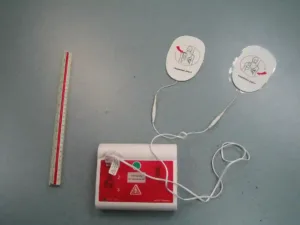The material posted on this page is for information purposes only. If you want to learn to effectively use a AED take a St Mark James CPR or first aid course (link is to our providers in Halifax). The following page is dedicated to facts about AED’s and how they are used.
- An AED will not work effectively on a victim that has a wet or sweaty chest. The chest must be dried prior to application.
- A victims chest must be fully exposed prior to applying AED pads.
-
AED trainer used in CPR and AED classes AED pads are one time use only so rescuers must be careful to carefully place pads in the correct location on the first application. Rescuers must be careful not to contact the adhesive end of a AED pad when applying.
- Adult AED pads can be used on a child but child pads can not be used on a adult. When applying adult pads on a child the pads must be at least 1 inch apart to work effectively.
- 2 minutes of CPR is required prior to using a AED on a child.
- Some AED’s now have pediatric pads that can be placed on a infant.
- All AED’s are required to be simple and have a on or power button and a shock button.
- It is recommended that the AED stays on the rescuers side so that the rescuer does not have to reach over the victim to shock.
- AED pads CAN be placed on a hairy chest. Shaving a hairy chest with a single blade razor that is commonly found in first aid kits will take a significant amount of time. AED have been found to work effectively when placed over a hairy chest.
- AED pads should be placed below or away from pacemakers.
- AED pads CAN be placed when the victim has a automated internal defibrillators.
- Nipple piercing can be left on the victim when using a AED.
- The victim should not have any part of the body in a swimming pool when using a AED.
- General electric conducted a study to discover the effects of the rescuer and victim being in the same puddle when a AED is in use and discovered that the rescuer would not suffer any significant shock. However, candidates can still conduct a “splash” test and move the victim’s body to appropriate location prior to shocking.
- If the rescuer and victim are on the same metallic object the rescuer is advised to stand when shocking (rubber soles prevent shock).
- Rescuers should still attempt to “shock” victims when the low battery prompt is on.

